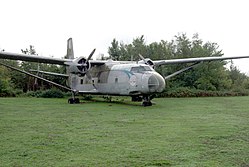Hurel-Dubois HD.32
| Hurel-Dubois HD.31 / 32/34 | |
|---|---|
 A Hurel-Dubois HD.34 ( F-BICV ) |
|
| Type: | Passenger plane |
| Design country: | |
| Manufacturer: |
Hurel-Dubois |
| First flight: |
December 29, 1953 (HD.32) |
The Hurel-Dubois HD.32 was a French passenger aircraft . The Hurel-Dubois HD.321 and Hurel-Dubois HD.34 were derived from it .
history
The Hurel-Dubois HD.32 was built from only one copy in the early 1950s HD.31 developed. She placed particular emphasis on good STOL skills. It should be able to be parked outdoors and also be used from unpaved slopes. The HD.32 was to be used on short-haul routes in the French colonies, replacing obsolete models such as the Ju 52 built in France after the war as the AAC.1 Toucan . Less emphasis was placed on a higher top speed than on very good STOL skills. In the end, however, this interpretation should contribute to its failure. The biggest problem then, however, was that when it was operational in the mid-1950s, France took over the planned areas of operation, e.g. B. 1954 had lost the colony of Indochina .
The first flight of the HD.32 took place on December 29, 1953 in Brétigny-sur-Orge. The aircraft had the registration F-WHHA.
construction
The aircraft was structurally a lattice-like braced high- wing aircraft made of metal. A noticeable specialty is the Hurel-Dubois narrow wing with its unusually high aspect ratio . The very narrow wing had a wingspan of 45.30 m (for comparison: a significantly larger Boeing 737-100 has a wingspan of only 28.35 m). The Hurel-Dubois narrow wing, reminiscent of high-performance gliders, gave the HD.32 excellent low-speed flight characteristics and thus also made it possible to use it at smaller airports. Despite the very good take-off and landing characteristics, this wing shape has not caught on, although it has been used successfully on British aircraft such as the Short Skyvan .
The non-retractable nose landing gear is aerodynamically clad and designed to be very robust. It enabled the HD.32 to operate from unpaved slopes.
The HD.32 was powered by two Pratt & Whitney R-1830 radial engines with 1220 hp each and reached a top speed of around 350 km / h. The maximum cruising speed was 338 km / h with engines throttled to 960 hp. The normal cruising speed with the engines then throttled to 608 hp was about 270 km / h, only slightly above the level of the aircraft that the HD.32 was to replace.
As a pure cargo aircraft, it had a 58 m³ cargo space; 44 passenger seats could be installed in the passenger version. The planned combined version would have had 34 passenger seats and a 12.8 m³ cargo hold.
Since there was hardly any radar monitoring and control in the planned area of operation, the French colonies, a radio navigator was located on the right-hand side behind the seat of the second pilot.
Technical specifications
| Parameter | Data |
|---|---|
| crew | two pilots and optionally a radio navigator |
| Passengers | 34 to 44 depending on the version |
| length | 23.27 m |
| span | 45.30 m |
| height | 8.73 m |
| Wing area | 100 m² |
| Wing extension | 20.5 |
| Empty mass | 11,200 kg |
| Max. Takeoff mass | 18,000 kg |
| Engines | two Pratt & Whitney R-1830s with 1,220 hp (897 kW) each |
| Max. Cruising speed | 338 km / h with engines throttled to 2 × 960 PS (706 kW) |
| normal cruising speed | 270 km / h with engines throttled to 2 × 608 PS (447 kW) |
| Range | 1,800 km |
| Takeoff route | 650 m |
| Take-off distance over 11 m | 790 m |
| Landing distance from a height of 15 m | 700 m |
| Landing runway | 200 m |
Further developments
In 1955, 23 units of the HD.32 were ordered by Air France in the extended version HD.321 . Even before the delivery to Air France, the latter canceled the order. The two HD.321s that had already been built were assigned to the French Air Force and tested in Algeria from August 1st to 26th, 1956 . They were then assigned to a test unit and used until 1959 as a tactical transporter, but also for mapping from the air and for experiments in air refueling.
Their further development, the Hurel-Dubois HD.34, has a retractable nose wheel for the first time. The first flight of the HD.34 took place on February 26, 1957. All eight copies built were delivered to the French National Geographic Institute and used for cartographic surveys by aerial photo. An aircraft ( aircraft registration F-BICU ) was briefly leased to the British Silver City Airways in 1959 , but they did not place an order. It wasn't until 1985 that the Hurel-Dubois HD.34s were replaced by Falcon 20S and Beechcraft 200T Super King Airs at the National Geographic Institute . Of the eight aircraft built, three have been preserved:
- Serial number 1, registered as F-BHOO , then F-AZNH , has been a listed building since December 2008 and is kept in the Aviation Museum of Melun-Villaroche,
- Serial number 4, registered in the aeronautical register as F-BICR , is kept in the Aerospace Museum in Le Bourget ,
- Serial number 8, registered as F-BICV , is kept on the Creil site.
literature
- Flieger-Jahrbuch 1958 , Verlag Die Wirtschaft Berlin, publisher: Heinz AF Schmidt, license number 122, printing permission 195/273/57, page 65
Individual evidence
- ^ Silver City Airways, Company Fleet List , accessed June 8, 2020